Solar and Lunar Eclipses in 2016
This year there's a total solar eclipse on March 9th (visible from Indonesia) and an annular on September 1st (central Africa). But the terrific "tetrad" of total lunar eclipses is over — we'll see just two barely-there penumbral eclipses, on March 23rd and September 16th.
Any list of nature's grandest spectacles would certainly include eclipses of the Sun and Moon. Up to seven of them can take place in one year, though the last time that happened was 1982. The fewest possible is four, as will be the case in 2016. Neither of the solar eclipses — one total and one annular — is observable from the Americas. And both lunar eclipses will involve extreme grazes of Earth's shadow that will challenging to notice at all.
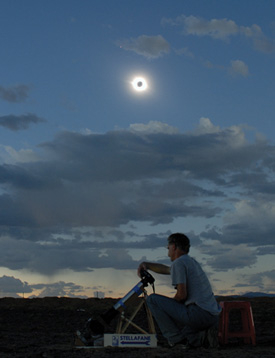
Few events in nature offer the drama and spectacle of a total solar eclipse. This one occurred over China on August 1, 2008.
S&T: Dennis di Cicco
S&T: Dennis di Cicco
Why Do Eclipses Happen?
A solar eclipse, such as the one pictured at right, occurs only at new Moon, when the lunar disk passes directly between us and the Sun. Conversely, a lunar eclipse takes place during full Moon, when our satellite passes through Earth's shadow.
These alignments don't happen at every new and full Moon because the lunar orbit is tipped about 5° to Earth's orbital plane — only occasionally do the Sun, Earth, and Moon line up exactly enough for an eclipse to occur. (The technical name for that, by the way, is syzygy.)
Three types of lunar eclipse are possible (total, partial, and penumbral) depending on how deeply the full Moon plunges into or near the umbra, our planet's dark, central shadow.
If it goes all the way in, we see a total lunar eclipse that's preceded and followed by partial phases. That was the case during the widely viewed event in September 2015, which marked the conclusion of a series of four consecutive total lunar eclipses in 2014–15! Such eclipse tetrads are not common — the last one occurred during 2003–04, but the next won't begin until 2032.
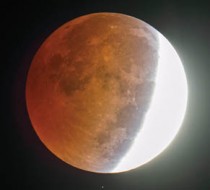
A long-exposure image captured red hues on the portion of the Moon inside the umbra during the lunar eclipse on October 8, 2014.
Johnny Horne
Johnny Horne
If the Moon skims part way into the umbra, only the partial phases occur. And if its disk passes just outside the umbra, it still encounters the weak penumbral shadow cast by Earth. This third geometry, the least impressive visually, will be in play during 2016's two lunar eclipses.
Fortunately, every lunar eclipse is observable anywhere on Earth where the Moon is above the horizon. (But there's still an element of luck involved — after all, the sky has to be clear!)
However, solar eclipses more tightly restrict where you can see them because the Moon casts a smaller shadow than Earth does. If the Moon completely hides the Sun, the eclipse is considered total. With its brilliant disk completely covered, the Sun's ghostly white outer atmosphere is momentarily revealed for durations from seconds to several minutes. In November 2013, for example, planeloads of eclipse-chasers converged in a remote portion of northern Kenya to watch just 11 seconds of totality.
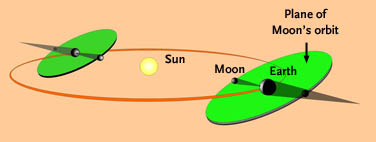
Eclipses of the Sun or Moon can only occur when the Moon crosses the plane of Earth's orbit (orange circle) very close to the time of new or full Moon.
Jay Anderson
Jay Anderson
A completely eclipsed Sun can be viewed only from a narrow track or path on Earth's surface that's typically just 100 miles (160 km) wide. Outside of that path, about half of the daylit hemisphere of Earth is able to watch a partial eclipse as the Moon obscures a portion of the Sun.
Occasionally the Moon passes directly in front of the Sun but doesn't completely cover it. This circumstance is known as an annular eclipse, so-called because you can see a ring, or annulus, of sunlight surrounding the lunar disk. But an annular's path is likewise narrow, and outside of it observers see only a partial cover-up.
The Four Eclipses in 2016
Below are brief descriptions of this year's eclipses of the Sun and Moon. You'll find more details Sky & Telescope magazine as the date of each draws near. Times are in Universal Time (UT) except as noted.
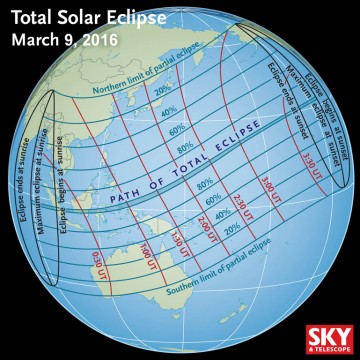
The total solar eclipse on March 9, 2016, makes landfall only among the islands of Indonesia. At any location, interpolate between the red lines to find the Universal Time of greatest eclipse. Interpolate between the blue lines to see what percent of the Sun’s diameter the Moon will cover at that time.
S&T: Leah Tiscione / source: F. Espenak
S&T: Leah Tiscione / source: F. Espenak
March 9: Total Solar Eclipse
Whenever the Moon covers the Sun, the narrow path of totality can be anywhere in the world — often traversing remote locations. The path of this year's total solar eclipse is doubly challenging — both to get to and to see once there. Although the totally eclipsed Sun will rise in the Indian Ocean and set north of Hawai‘i, much of the track crosses open ocean. The path makes landfall in parts of Sumatra, Borneo, and Sulawesi. Sky & Telescope offers a ship-based expedition to see this event.
This eclipse offers up to 4m 9s of totality, but moment point of greatest eclipse (at 1:57:11 UT) occurs in a virtually unreachable stretch of the western Pacific.
Because the Moon is near perigee and thus looks somewhat larger than usual in the sky, the area from which a partly covered Sun can be seen is also large. As the map here shows, a partial eclipse is observable from Southeast Asia, China, Japan, and parts of Australia. Those in Hawai'i see about two-thirds of the Sun's disk covered near sunset on March 8th.
March 23rd: Penumbral Lunar Eclipse
It's not uncommon for a solar eclipse (new Moon) to be followed two weeks later by a lunar eclipse (full Moon), or vice versa. However, March 23rd's event only barely qualifies as a lunar eclipse. On that morning, skywatchers in western North America and Hawai‘i should detect the southern side of the full Moon skimming through the pale outer fringe of Earth’s shadow. This weak eclipse will be deepest at 11:47 UT (4:47 a.m. PDT, 5:47 a.m. MDT), when the Moon will intrude 78% of the way across the penumbra’s width. That’s not far enough for the most obvious part of the penumbra to show, but far enough that you should have little trouble seeing that something is a bit amiss. For Australia and East Asia, the event falls on the evening of March 23rd local date.
September 1: Annular Solar Eclipse
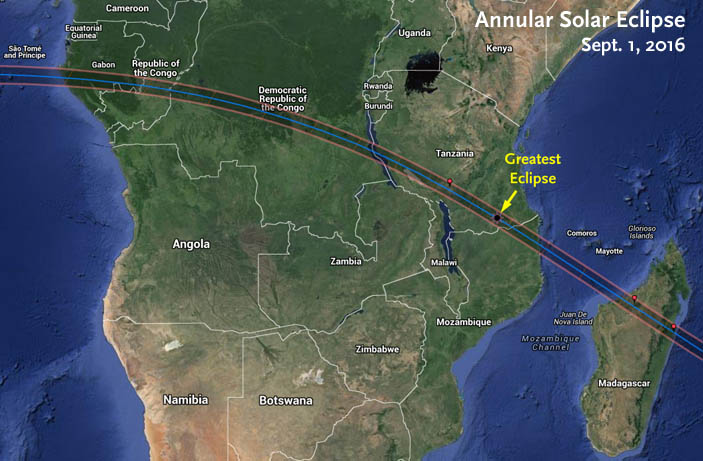
Here's the path of annularity across central Africa for the solar eclipse on September 1, 2016.
Xavier Jubier
Xavier Jubier
Annular solar eclipses typically occur when the Moon is its farthest from Earth, and that's the situation on September 1st (apogee falls on the 6th).
This time the relatively narrow track crosses central Africa and specifically parts of Gabon, Congo, Democratic Republic of the Congo, Tanzania, Mozambique, and Madagascar. At the moment of greatest eclipse, 9:06:54 UT, well-placed observers in Mozambique get to see the Moon's disk completely silhouetted by sunlight for 186 seconds. The area where partial phases occur extends across virtually all of Africa and parts of the Arabian Peninsula.
September 16: Penumbral Lunar Eclipse
The year's fourth and final eclipse is another barely-there circumstance during which the Moon again slides through Earth's vague outer shadow. Dusky shading on the lunar disk's northern half should be easy to spot when the eclipse reaches its maximum at 18:54 UT. However, no one in North America will see it. Instead, this event is well placed for observers in Europe, Africa, and Asia.
Looking Ahead to 2017
The mix of events next year will be much the same: one annular solar eclipse (February 26th) and one total (August 21st), along with a penumbral lunar eclipse on February 11th and a partial lunar eclipse on August 7th. However, there's no question that August 21st's totality will be a Really Big Deal, as the path crosses the United States from Oregon to South Carolina. Such a coast-to-coast track across U.S. hasn't happened since 1918. Here's a preview of what to expect.
1 comment:
Jeep safari in corbett is well known in all over world as wildlife jeep safari and people want to have at any cost if you are one of them who are looking for a wildlife tour so Jim Corbett National Park is best destination for you.
Post a Comment